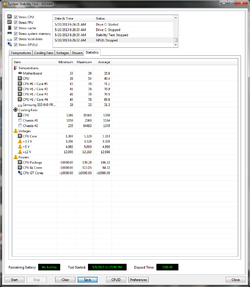dvsone1440
New Member
- Joined
- May 10, 2013
New to building computers... Managed to get it together and works really well.. right up until it doesn't.
I am an architect and built a computer for modeling and rendering. The modeling program I use is a 32 bit program, so I wanted to overclock as clock speed makes a huge difference in the modeling program usability. The computer works great, but.. Its been shutting down on me every few days. Typically when rendering (Maxwell render) and it is using all the cores 100%.
I currently have it overclocked only with the tpu switch.. 4.1ghz
The components are asus p9x79/ intel i7 3930/ corsair dominator 32gb/ corsair 850w 80+/ corsair h100i radiator/ nvidia quadro 4000 / samsung pro 500gb.
Temperatures are very stable.. 73 c was the highest I saw in the 8 hr stress test. I have the latest asus bios installed. Windows 7 64 bit.
I installed aida 64 and get no error messages after running it for 8 hrs.
The one strange thing I noticed was in the power tab it mostly a straightish line graph but every once and a while drops off precipitously. The Power minimums all read -10000.
Again I really don't know what I am doing so hoping to get some ideas of where to start. Googling around there does not seem to be any solutions to this crash that I can find.
I am an architect and built a computer for modeling and rendering. The modeling program I use is a 32 bit program, so I wanted to overclock as clock speed makes a huge difference in the modeling program usability. The computer works great, but.. Its been shutting down on me every few days. Typically when rendering (Maxwell render) and it is using all the cores 100%.
I currently have it overclocked only with the tpu switch.. 4.1ghz
The components are asus p9x79/ intel i7 3930/ corsair dominator 32gb/ corsair 850w 80+/ corsair h100i radiator/ nvidia quadro 4000 / samsung pro 500gb.
Temperatures are very stable.. 73 c was the highest I saw in the 8 hr stress test. I have the latest asus bios installed. Windows 7 64 bit.
I installed aida 64 and get no error messages after running it for 8 hrs.
The one strange thing I noticed was in the power tab it mostly a straightish line graph but every once and a while drops off precipitously. The Power minimums all read -10000.
Again I really don't know what I am doing so hoping to get some ideas of where to start. Googling around there does not seem to be any solutions to this crash that I can find.

 to the forums!
to the forums!